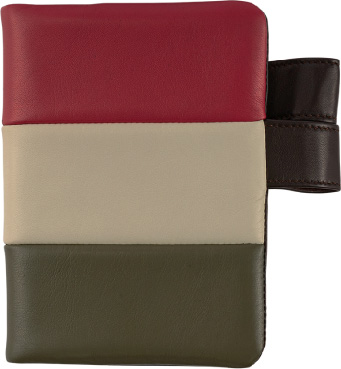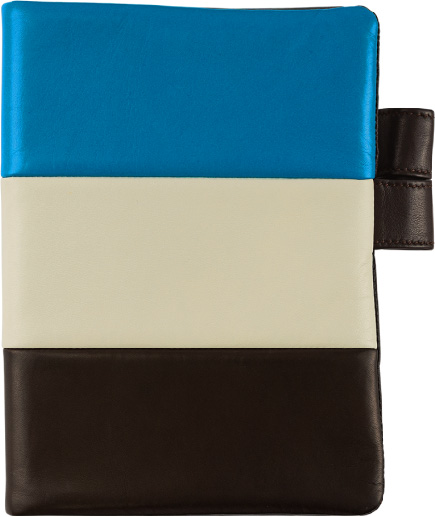A Gift from Ethiopia
This year’s andu amet techo cover uses Ethiopian sheepskin that’s amazingly soft to the touch. We talked to andu amet representative and designer Hiroko Samejima about the secret to this special leather and her thoughts about craftsmanship.
> About Hiroko Samejima

- “Bloom”
A6 size cover

- “Nile Breeze”
A5 size cover
− Part 1 of 2 −
Special Sheep Conditioned for Fine Leather
- The andu amet leather cover this year turned out magnificently. The best part is the amazingly soft sheepskin. Could you tell us more about it?
- Samejima
- It’s called Abyssinian Highland sheepskin, and the sheep it comes from can only be found in Ethiopia. There are two main kinds of sheep in the world: hair sheep and wool sheep. Wool sheep are the ones with cute, fluffy wool, and are mainly found in New Zealand and Australia. While their wool is high quality, their leather isn’t as good. Hair sheep don’t have high-quality hair, but their leather is great. Abyssinian Highland sheep are related to hair sheep.
- So their leather is higher quality than their hair.

- Samejima
- Not only that, but the environment these sheep live in actually makes their leather superior to other sheepskin. Sheepskin is at its best when sheep are raised where temperatures vary a lot, at an altitude of 3000 meters, and 10 degrees north of the equator. The Abyssinian Highland sheep of Ethiopia fit those exact conditions, so the fibers of the leather are especially strong and dense.
- So all the conditions are perfect.
- Samejima
- Abyssinian Highland sheepskin is as soft and smooth as a baby’s skin. And even though it’s soft, it’s also incredibly durable. It’s even stronger than other leather of the same thickness, like cowhide. If you try to pierce it with something sharp, like the tip of a pen, you won’t penetrate it.
- It’s amazing that something can be so soft and so strong at the same time.
- Samejima
- Abyssinian Highland sheepskin is often used in products like golf gloves.

Processing leather naturally when it’s this high of quality
- You’ve told us about the quality of the sheepskin itself. Is there anything else you can tell us about it?
- Samejima
- Even after you’ve tanned the sheepskin, it remains different from standard leathers. Most of the leathers on the market are processed with colored pigments. This hides imperfections in the leather, but it also destroys the benefits of the leather.
- I see.
- Samejima
- Our leather uses dyes rather than pigments. This gives the coloring a sort of translucent look. While it can’t hide any flaws in the leather, it also doesn’t hide its strengths. The dye process used in this leather is usually reserved for only the highest quality leather and products. I really believe in the quality of this sheepskin, so I try to make sure it’s kept as natural as possible. It is susceptible to water damage and scraping, so it requires some care when handling.
- So it’s processed in a way that capitalizes on the quality of the leather itself.
- Samejima
- You can see any naturally-occuring markings, discoloration, and stains on the leather, but that’s just a symbol of the free-roaming life these animals enjoy.

- Yeah, certainly.
- Samejima
- The leather used in these covers includes some white leather, and since white becomes dirty more easily, we did apply a light layer of pigmentation on top of that section. The pink and light blue leathers have an even lighter layer of pigmentation applied to them, but the dark brown areas don’t contain any pigmentation. In addition, the dark brown areas on the inside of the cover are tanned in a different way. So we’ve paid special attention to the colors and positioning of the leather on the cover to determine how we process each part.
- What a detail-oriented approach.
- Samejima
- For instance, you’ll notice that if you touch the white area on the front it feels slightly firm, while the dark brown area feels soft.

Finding what I wanted to do
- How did you come to learn about this Ethiopian leather?
- Samejima
- I started out as a designer in a Japanese company. I traveled to Ethiopia in 2002 for volunteer work, and that’s when I came across this amazing leather. However...
- However?
- Samejima
- At the time, this leather was almost exclusively exported as raw leather. It would be exported to Italy, where it was tanned and sold as Italian leather, or imported into France and assembled there as French-made bags.This leather was being sold to high-status brands, who then sold it for tens or even hundreds of times the original price, but that status as a treasured leather wasn’t bringing any money back into Ethiopia. Not only does that not help the country financially, but it doesn’t support the growth of local craftsmen.
- I see.
- Samejima
- Trends and fast fashion dominate the industry, but I was becoming more interested in creating products outside of mass production and mass consumption. With Ethiopian leather it was like I’d found the answer to what I really wanted to do. It would make me happier, and it seemed like it could benefit the people of Ethiopia as well as potential clients. After I returned to Japan, I began working in marketing at a foreign-owned company, and in 2012 I founded andu amet.

(Continued)> Part 2 / NEXT